Analysis of Non-Equilibrium and Equilibrium Models of Heat and Moisture Transfer in a Wet Porous Building Material †
Abstract
:1. Introduction
2. Descriptions of Models
2.1. General Assumptions
2.2. Non-Equilibrium Model
2.3. Equilibrium Model
2.4. Material Properties and Closure Relationships
- Pore area per unit volume:
- Vapor diffusivity in pores:
- Effective thermal conductivity of the moist brick:
- Water permeability in the brick:
- Vapor saturation pressure:
- Modified saturation pressure:
- Liquid saturation:
- Retention curve which was applied to find the capillary pressure:
- Water vapor density for saturation conditions:
- Effective heat capacity:
- Specific enthalpies:
3. Numerical Implementation
3.1. Description of the Studied Case
3.2. Numerical Implementation of Models
3.2.1. Non-Equilibrium Model
3.2.2. Equilibrium Model
4. Results and Discussion
5. Conclusions
Author Contributions
Funding
Conflicts of Interest
References
- Whitaker, S. Simultaneous heat, mass, and momentum transfer in porous media: A theory of drying. Adv. Heat Transf. 1977, 13, 119–203. [Google Scholar]
- Salagnac, P.; Glouannec, P.; Lecharpentier, D. Numerical modeling of heat and mass transfer in porous medium during combined hot air, infrared and microwaves drying. Int. J. Heat Mass Transf. 2004, 47, 4479–4489. [Google Scholar] [CrossRef]
- Van Belleghem, M.; De Backer, L.; Janssens, A.; De Paepe, M. On the modelling of moisture transport in air and capillary porous materials. In Proceedings of the 9th International Conference on Heat Transfer, Fluid Mechanics and Thermodynamics, HEFAT2012, St Julian’s, Malta, 16–18 July 2012. [Google Scholar]
- Hagentoft, C.-E.; Kalagasidis, A.S.; Adl-Zarrabi, B.; Roles, S.; Carmeliet, J.; Hens, H.; Grunewald, J.; Funk, M.; Becker, R.; Shamir, D.; et al. Assessment method of numerical prediction models for combined heat, air and moisture transfer in building components. Benchmarks for one-dimensional cases. J. Build. Phys. 2004, 27, 327–352. [Google Scholar] [CrossRef]
- Van Belleghem, M.; Steeman, M.; Janssen, H.; Janssens, A.; De Paepe, M. Validation of a coupled heat, vapour and liquid moisture transport model for porous materials implemented in CFD. Build. Environ. 2014, 81, 340–353. [Google Scholar] [CrossRef] [Green Version]
- Steeman, H.-J.; Van Belleghem, M.; Janssens, A.; De Paepe, M. Coupled simulation of heat and moisture transport in air and porous materials for the assessment of moisture related damage. Build. Environ. 2009, 44, 2176–2184. [Google Scholar] [CrossRef]
- Van Belleghem, M.; Steeman, H.-J.; Steeman, M.; Janssens, A.; De Paepe, M. Sensitivity analysis of CFD coupled non-isothermal heat and moisture modelling. Build. Environ. 2010, 45, 2485–2496. [Google Scholar] [CrossRef] [Green Version]
- Janetti, B.M.; Colombo, L.P.M.; Ochs, F.; Feist, W. Effect of evaporation cooling on drying capillary active building materials. Energy Build. 2018, 166, 550–560. [Google Scholar] [CrossRef]
- Belleudy, C.; Woloszyn, M.; Chhay, M.; Cosnier, M. A 2D model for coupled heat, air, and moisture transfer through porous media in contact with air channels. Int. J. Heat Mass Transf. 2016, 95, 453–465. [Google Scholar] [CrossRef] [Green Version]
- Allam, R.; Issaadi, N.; Belarbi, R.; El-Meligy, M.; Altahrany, A. Hygrothermal behavior for a clay brick wall. Heat Mass Transf. 2018, 54, 1579–1591. [Google Scholar] [CrossRef]
- Łapka, P.; Wasik, M.; Furmański, P.; Seredyński, M.; Cieślikiewicz, Ł.; Pietrak, K.; Kubiś, M.; Wiśniewski, T.S.; Jaworski, M. Preliminary mathematical and numerical transient models of convective heating and drying of a brick. MATEC Web Conf. 2018, 240, 01022. [Google Scholar] [CrossRef]
- Wasik, M.; Cieślikiewicz, Ł.; Łapka, P.; Furmański, P.; Kubiś, M.; Seredyński, M.; Pietrak, K.; Wiśniewski, T.S.; Jaworski, M. Initial credibility analysis of a numerical model of heat and moisture transfer in porous building materials. AIP Conf. Proc. 2019, 2078, 020106. [Google Scholar]
- Cheng, X.; Fan, J. Simulation of heat and moisture transfer with phase change and mobile condensates in fibrous insulation. Int. J. Therm. Sci. 2004, 43, 665–676. [Google Scholar] [CrossRef]
- Łapka, P.; Furmański, P. Verification and validation of an advanced model of heat and mass transfer in the protective clothing. Heat Mass Transf. 2018, 54, 2461–2474. [Google Scholar] [CrossRef]
- Łapka, P.; Furmański, P.; Wiśniewski, T.S. Assessment of thermal performance of protective garments: The advanced numerical model. Int. J. Numer. Methods Heat Fluid Flow 2017, 27, 1078–1097. [Google Scholar] [CrossRef]
- Seredyński, M.; Wasik, M.; Łapka, P.; Furmański, P.; Cieślikiewicz, Ł.; Pietrak, K.; Kubiś, M.; Wiśniewski, T.S.; Jaworski, M. Investigation of the equilibrium and non-equilibrium models of heat and moisture transport in a wet porous building material. E3S Web Conf. 2019, 128, 06008. [Google Scholar] [CrossRef]
- Van Belleghem, M.; Ameel, B.; Janssens, A.; De Paepe, M. Modelling heat and moisture transport in porous materials with CFD for building applications. In Proceedings of the 8th International Conference on Heat Transfer, Fluid Mechanics and Thermodynamics, HEFAT2011, Pointe Aux Piments, Mauritius, 11–13 July 2011; pp. 455–463. [Google Scholar]
- Van Belleghem, M. Modelling Coupled Heat and Moisture Transfer between Air and Porous Materials for Building Applications. Ph.D. Thesis, Ghent University, Ghent, Belgium, 2013. [Google Scholar]
- Cieślikiewicz, Ł.; Łapka, P.; Wasik, M.; Kubiś, M.; Pietrak, K.; Wiśniewski, T.S.; Furmański, P.; Seredyński, M. Development of the experimental stand for investigation of heating and drying phenomena in the porous building materials with one surface of the sample exposed to the flowing air. E3S Web Conf. 2018, 70, 03003. [Google Scholar] [CrossRef]
- Cieślikiewicz, Ł.; Wasik, M.; Kubiś, M.; Łapka, P.; Bugaj, M.; Pietrak, K.; Wiśniewski, T.S.; Furmański, P.; Seredyński, M. Development of the experimental stand with centrally located specimen for the investigation of heat and moisture phenomena in porous building materials. Civ. Environ. Eng. Rep. 2019, 29, 53–65. [Google Scholar] [CrossRef] [Green Version]

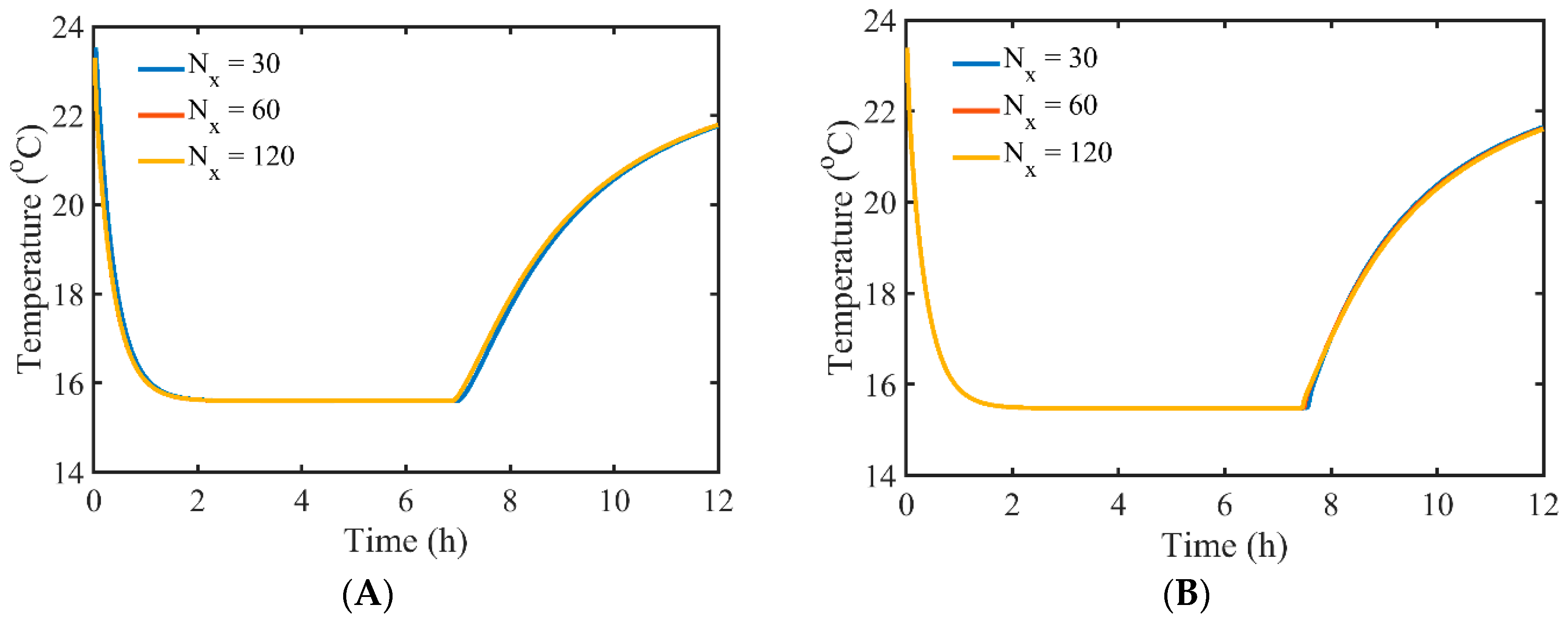
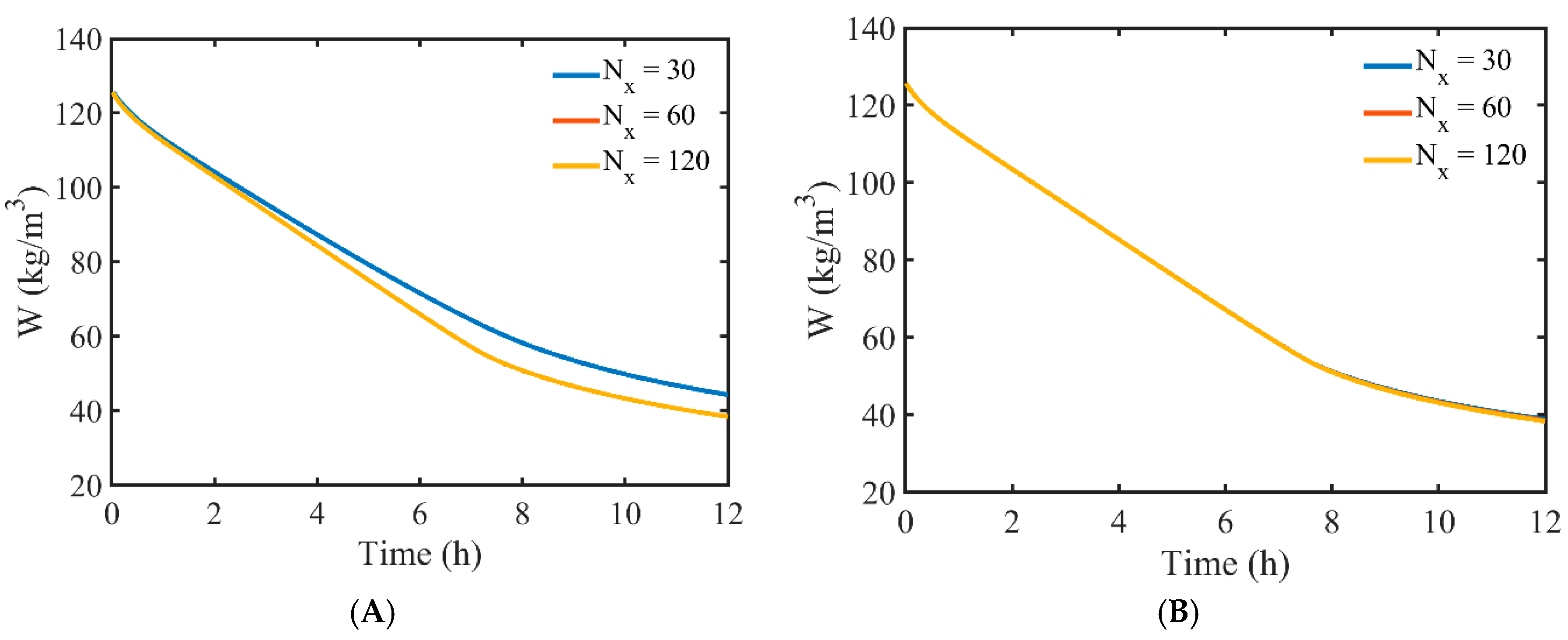
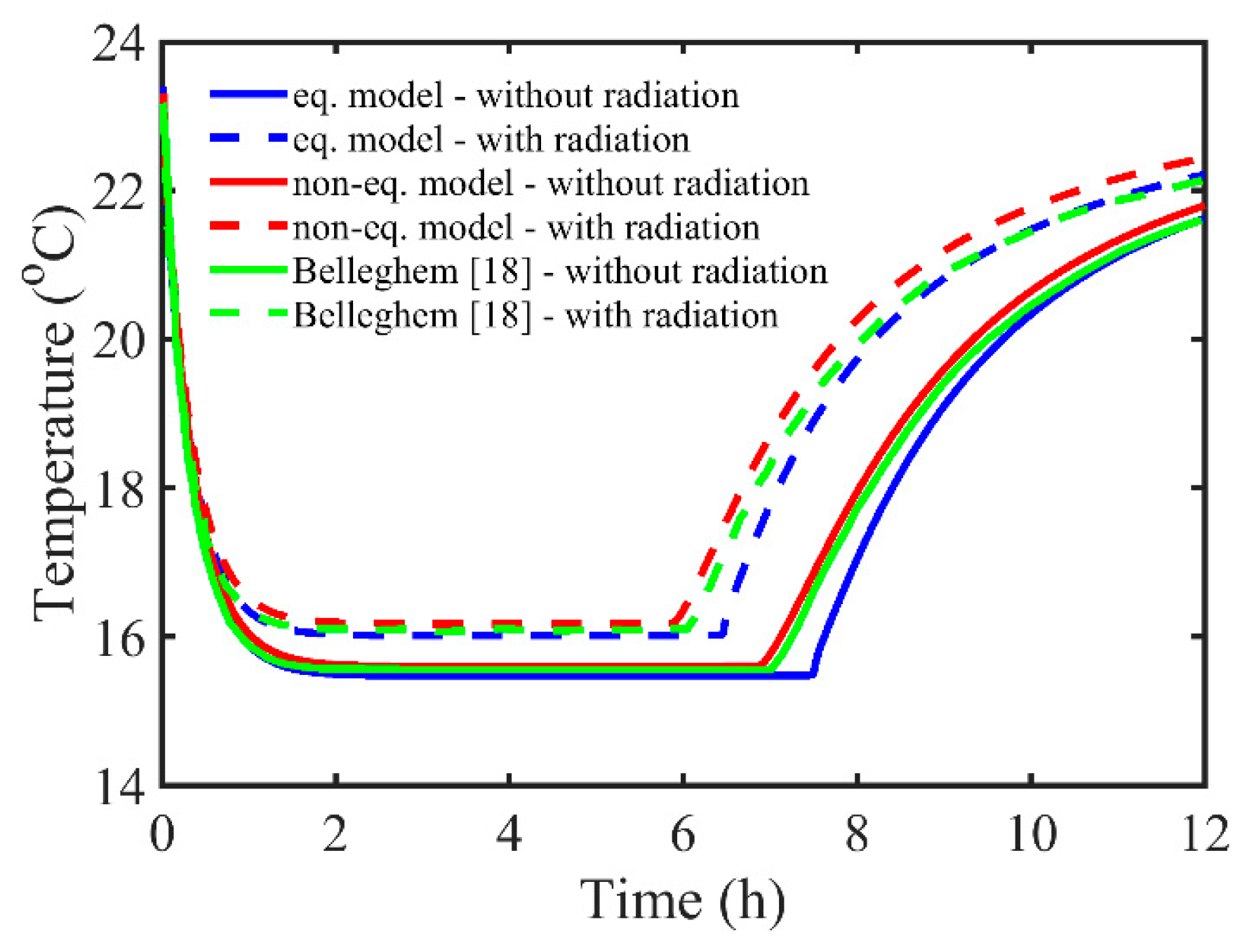
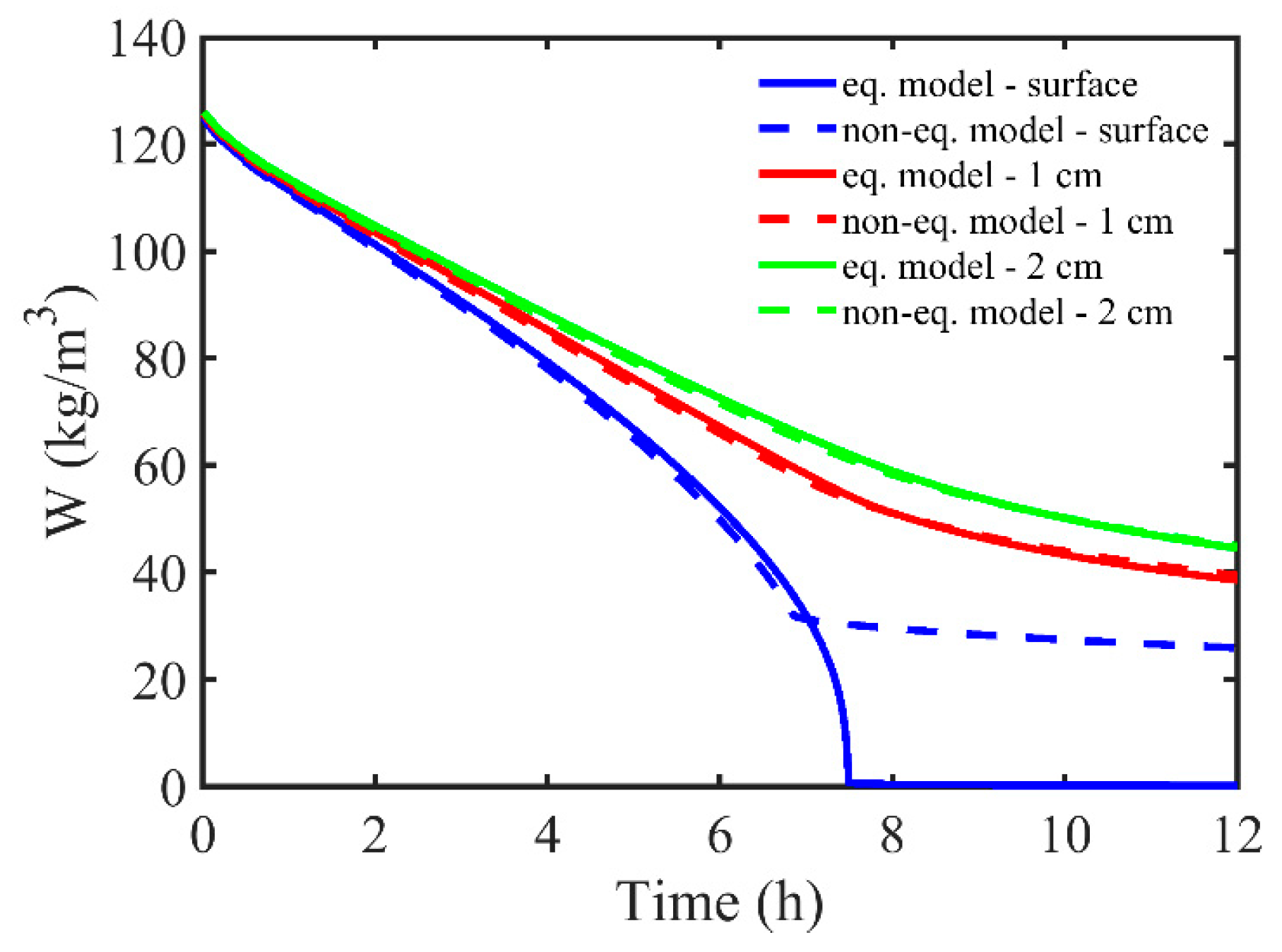
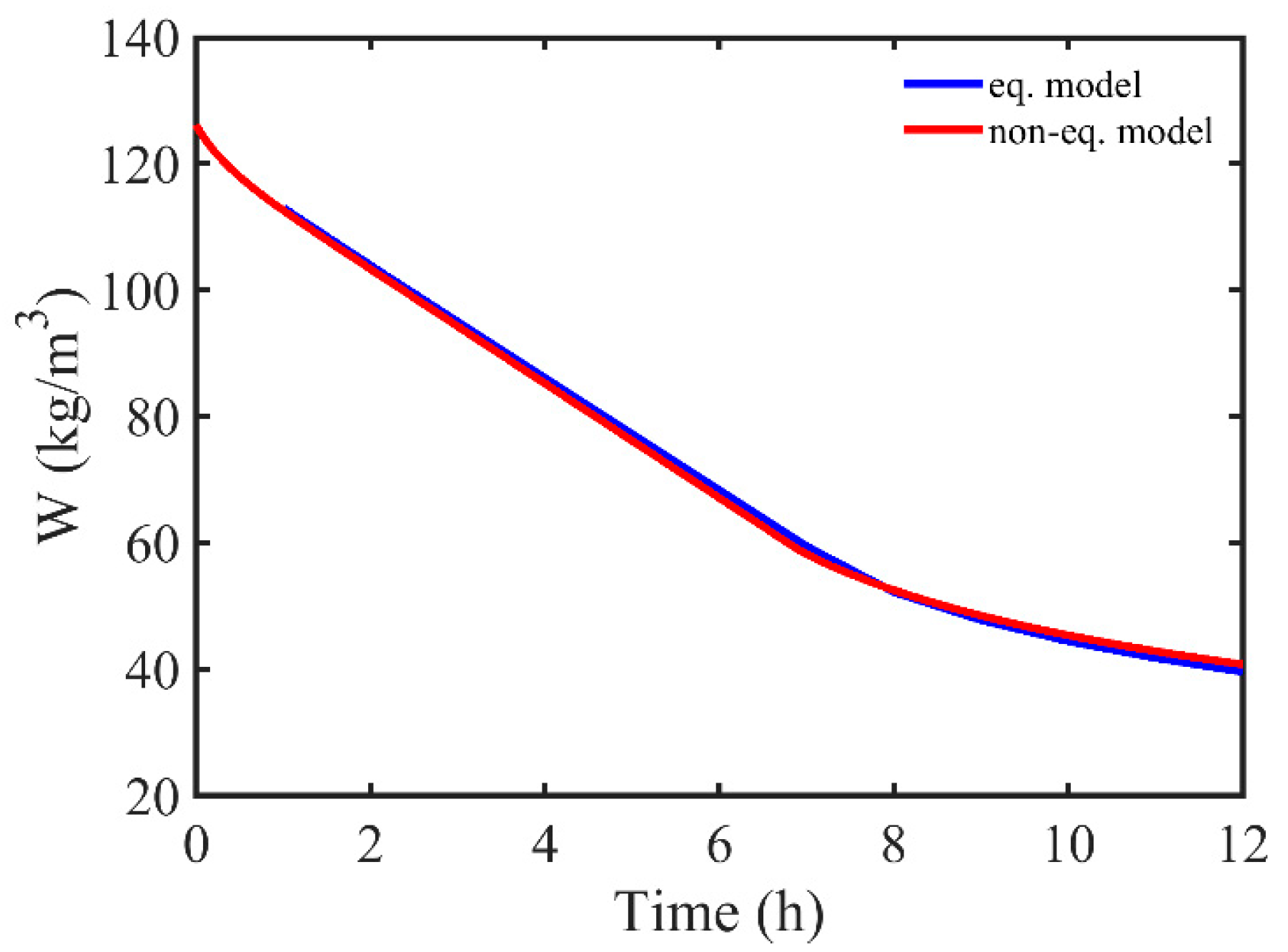
| Property | Symbol and Unit | Value |
|---|---|---|
| Universal gas constant | B (J/kmol/K) | 8314 |
| Dry air specific heat at constant pressure | cp,a (J/kg/K) | 1005.0 |
| Water specific heat | cl (J/kg/K) | 4192.1 |
| Brick specific heat | cs (J/kg/K) | 840.0 |
| Vapor specific heat at constant pressure | cp,v (J/kg/K) | 1875.2 |
| Water vapor resistance diffusion factor | Cdry | 24.79 |
| Average pore diameter | dav (m) | 1.6 × 10−5 |
| Mass transfer coefficient between vapor and water in the porous medium | hvl (m/s) | 10−4 |
| Brick thermal conductivity | ks (W/m/K) | 1.0 |
| Dry air molecular mass | Ma (kg/kmol) | 28.86 |
| Vapor molecular mass | Mv (kg/kmol) | 18 |
| Capillary moisture content | Wcap (kg/m3) | 130.0 |
| Volume fraction of pores (brick porosity) | εp | 0.13 |
| Latent heat of evaporation | Δhvl (J/kg) | 2.5 × 106 |
| Water density | ρl (kg/m3) | 1000.0 |
| Brick density | ρs (kg/m3) | 2087.0 |
© 2020 by the authors. Licensee MDPI, Basel, Switzerland. This article is an open access article distributed under the terms and conditions of the Creative Commons Attribution (CC BY) license (http://creativecommons.org/licenses/by/4.0/).
Share and Cite
Seredyński, M.; Wasik, M.; Łapka, P.; Furmański, P.; Cieślikiewicz, Ł.; Pietrak, K.; Kubiś, M.; Wiśniewski, T.S.; Jaworski, M. Analysis of Non-Equilibrium and Equilibrium Models of Heat and Moisture Transfer in a Wet Porous Building Material. Energies 2020, 13, 214. https://doi.org/10.3390/en13010214
Seredyński M, Wasik M, Łapka P, Furmański P, Cieślikiewicz Ł, Pietrak K, Kubiś M, Wiśniewski TS, Jaworski M. Analysis of Non-Equilibrium and Equilibrium Models of Heat and Moisture Transfer in a Wet Porous Building Material. Energies. 2020; 13(1):214. https://doi.org/10.3390/en13010214
Chicago/Turabian StyleSeredyński, Mirosław, Michał Wasik, Piotr Łapka, Piotr Furmański, Łukasz Cieślikiewicz, Karol Pietrak, Michał Kubiś, Tomasz S. Wiśniewski, and Maciej Jaworski. 2020. "Analysis of Non-Equilibrium and Equilibrium Models of Heat and Moisture Transfer in a Wet Porous Building Material" Energies 13, no. 1: 214. https://doi.org/10.3390/en13010214





